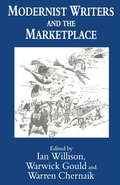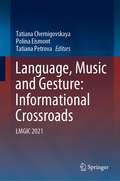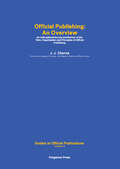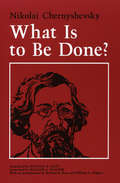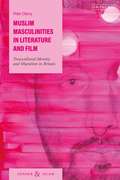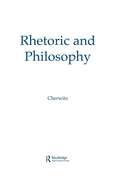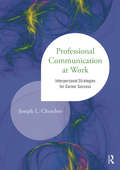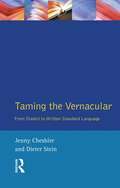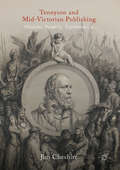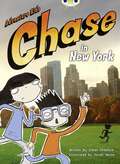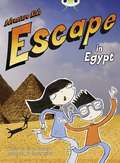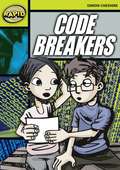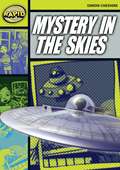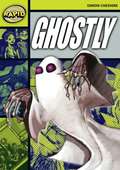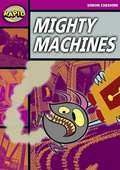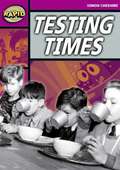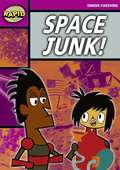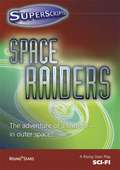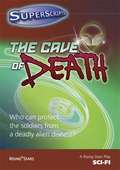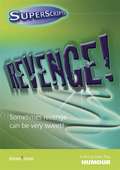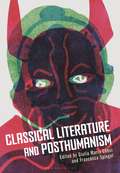- Table View
- List View
Modernist Writers and the Marketplace
by Warren Chernaik Warwick Gould Ian WillisonModernist Writers and the Marketplace is a new research-level collection devoted to an exciting area in the history of the book. Focusing on Henry James, W.B. Yeats, Joseph Conrad, D.H. Lawrence, Virginia Woolf, T.S. Eliot, James Joyce, Ezra Pound, Wyndham Lewis and the culture of the little magazine of the period, eleven contributors from six countries demonstrate new developments in the sociology of texts, the practice of literary biography, and textual criticism.
Language, Music and Gesture: LMGIC 2021
by Tatiana Chernigovskaya Polina Eismont Tatiana PetrovaThis book brings together selected revised papers representing a multidisciplinary approach to language, music, and gesture, as well as their interaction. Among the number of multidisciplinary and comparative studies of the structure and organization of language and music, the presented book broadens the scope with the inclusion of gesture problems in the analyzed spectrum. A unique feature of the presented collection is that the papers, compiled in one volume, allow readers to see similarities and differences in gesture as an element of non-verbal communication and gesture as the main element of dance. In addition to enhancing the analysis, the data on the perception and comprehension of speech, music, and dance in regard to both their functioning in a natural situation and their reflection in various forms of performing arts makes this collection extremely useful for those who are interested in human cognitive abilities and performing skills. The book begins with a philosophical overview of recent neurophysiological studies reflecting the complexity of higher cognitive functions, which references the idea of the baroque style in art being neither linear nor stable. The following papers are allocated into 5 sections. The papers of the section “Language-Music-Gesture As Semiotic Systems” discuss the issues of symbolic and semiotic aspects of language, music, and gesture, including from the perspective of their notation. This is followed by the issues of "Language-Music-Gesture Onstage" and interaction within the idea of the "World as a Text." The papers of “Teaching Language and Music” present new teaching methods that take into account the interaction of all the cognitive systems examined. The papers of the last two sections focus on issues related primarily to language: The section "Verbalization Of Music And Gesture" considers the problem of describing musical text and non-verbal behavior with language, and papers in the final section "Emotions In Linguistics And Ai-Communication Systems” analyze the ways of expressing emotions in speech and the problems of organizing emotional communication with computer agents.
Official Publishing: An Overview
by J. J. ChernsOfficial Publishing: An Overview is an international survey and review of the role, organization, and principles of official publishing. More specifically, it examines the organization, development, and effectiveness, including the economics, of state publishing as a means of communication between government and public, together with its relationship to the wider field of official information and communication activities. It also makes a broad comparison of the organization of publishing in the United Nations and its main agencies as well as some non-UN international organizations, particularly the European Communities and the OECD. Comprised of 32 chapters, this book opens with an introduction to the scope and importance of official publishing, followed by a discussion on official publishing in various countries such as Australia, Belgium, Canada, Denmark, Germany, and India as well as Hong Kong, Indonesia, Israel, Italy, Norway, Britain, and the United States. Official publishing in international organizations such as the United Nations, World Bank, OECD, NATO, and the European Communities is also considered. Subsequent chapters focus on various aspects of official information, including growth, framework, machinery, objectivity, accessibility, finance and economics, and control. The book also describes information centers and specialist entrepreneurs before concluding with an assessment of future prospects for official publishing. This monograph will be a useful resource for librarians, bibliographers, researchers, students, and other major users of the end-products of official publishing.
What Is to Be Done?
by Nikolai ChernyshevskyAlmost from the moment of its publication in 1863, Nikolai Chernyshevsky's novel, What Is to Be Done?, had a profound impact on the course of Russian literature and politics. The idealized image it offered of dedicated and self-sacrificing intellectuals transforming society by means of scientific knowledge served as a model of inspiration for Russia's revolutionary intelligentsia. On the one hand, the novel's condemnation of moderate reform helped to bring about the irrevocable break between radical intellectuals and liberal reformers; on the other, Chernyshevsky's socialist vision polarized conservatives' opposition to institutional reform. Lenin himself called Chernyshevsky "the greatest and most talented representative of socialism before Marx"; and the controversy surrounding What Is to Be Done? exacerbated the conflicts that eventually led to the Russian Revolution.Michael R. Katz's readable and compelling translation is now the definitive unabridged English-language version, brilliantly capturing the extraordinary qualities of the original. William G. Wagner has provided full annotations to Chernyshevsky's allusions and references and to the, sources of his ideas, and has appended a critical bibliography. An introduction by Katz and Wagner places the novel in the context of nineteenth-century Russian social, political, and intellectual history and literature, and explores its importance for several generations of Russian radicals.
Muslim Masculinities in Literature and Film: Transcultural Identity and Migration in Britain (Gender and Islam)
by Peter CherryA climate of Islamophobia allows anxieties about Muslim men living in and migrating to Britain to endure. British Muslims men are often profiled in highly negative terms or regarded with suspicion owing to their perceived religious and cultural heritage. But novels and films by British migrant and diaspora writers and filmmakers powerfully contest these stereotypes, and explore the rich diversity of Muslim masculinities in Britain. This book is the first critical study to engage with British Muslim masculinities in this literary and cinematic output from the perspective of Masculinity Studies. Through close analysis of work by Monica Ali, Nadeem Aslam, Guy Gunaratne, Sally El Hosaini, Hanif Kureishi, Suhayl Saadi, Sunjeev Sahota, Kamila Shamsie, Zadie Smith, Zia Haider Rahman and Salman Rushdie, Peter Cherry examines how migrant and diaspora protagonists negotiate their masculinity in a climate of Islamophobic and anti-migrant rhetoric. Cherry proposes a transcultural reading of these novels and films that exposes how conceptions of 'Britishness', 'Muslimness' and those of masculinity are unstable and contingent constructs shaped by migration, interaction with other cultures, and global and local politics.
Rhetoric and Philosophy
by Richard A. CherwitzThis important volume explores alternative ways in which those involved in the field of speech communication have attempted to find a philosophical grounding for rhetoric. Recognizing that rhetoric can be supported in a wide variety of ways, this text examines eight different philosophies of rhetoric: realism, relativism, rationalism, idealism, materialism, existentialism, deconstructionism, and pragmatism. The value of this book lies in its pluralistic and comparative approach to rhetorical theory. Although rhetoric may be the more difficult road to philosophy, the fact that it is being traversed by a group of authors largely from speech communication demonstrates important growth in this field. Ultimately, there is recognition that if different thinkers can have solid reasons to adhere to disparate philosophies, serious communication problems can be eliminated. Rhetoric and Philosophy will assist scholars in choosing from among the many philosphical starting places for rhetoric.
Rhetoric and Philosophy
by Richard A. Cherwitz Henry W. Johnstone Jr.This important volume explores alternative ways in which those involved in the field of speech communication have attempted to find a philosophical grounding for rhetoric. Recognizing that rhetoric can be supported in a wide variety of ways, this text examines eight different philosophies of rhetoric: realism, relativism, rationalism, idealism, materialism, existentialism, deconstructionism, and pragmatism. The value of this book lies in its pluralistic and comparative approach to rhetorical theory. Although rhetoric may be the more difficult road to philosophy, the fact that it is being traversed by a group of authors largely from speech communication demonstrates important growth in this field. Ultimately, there is recognition that if different thinkers can have solid reasons to adhere to disparate philosophies, serious communication problems can be eliminated. Rhetoric and Philosophy will assist scholars in choosing from among the many philosphical starting places for rhetoric.
Professional Communication at Work: Interpersonal Strategies for Career Success
by Joseph L. ChesebroThis text prepares future professionals for success in the workplace through identifying interpersonal communication skills and strategies and exploring when, how, and why to use them. Informed by academic research, professional literature, and author Joseph L. Chesebro’s own experiences, the text explores and demonstrates the skills that have facilitated Chesebro’s own students to find work and to succeed in their professional lives. Offering a very practical focus on such topics as handling conflict and giving dynamic presentations, Professional Communication at Work also covers essential interpersonal communication skills that are often not discussed, such as: Using networking when job hunting; Earning a good reputation as a new employee Using storytelling and questioning more often Developing coaching relationships with the best senior employees in our workplace, Practicing and developing new skills on our own, and Using workplace politics in a positive and constructive way to accomplish our goals. Utilizing the approach of a supportive communication coach, this text will help readers gain a variety of practical communication strategies they can apply to contribute to success in their own careers.
Professional Communication at Work: Interpersonal Strategies for Career Success
by Joseph L. ChesebroThis text prepares future professionals for success in the workplace through identifying interpersonal communication skills and strategies and exploring when, how, and why to use them. Informed by academic research, professional literature, and author Joseph L. Chesebro’s own experiences, the text explores and demonstrates the skills that have facilitated Chesebro’s own students to find work and to succeed in their professional lives. Offering a very practical focus on such topics as handling conflict and giving dynamic presentations, Professional Communication at Work also covers essential interpersonal communication skills that are often not discussed, such as: Using networking when job hunting; Earning a good reputation as a new employee Using storytelling and questioning more often Developing coaching relationships with the best senior employees in our workplace, Practicing and developing new skills on our own, and Using workplace politics in a positive and constructive way to accomplish our goals. Utilizing the approach of a supportive communication coach, this text will help readers gain a variety of practical communication strategies they can apply to contribute to success in their own careers.
Taming the Vernacular: From dialect to written standard language
by Jenny Cheshire Dieter SteinTaming the Vernacular: From Dialect to Written Standard Language examines the differences between 'standard' and 'nonstandard' varieties of several different languages. Not only are some of the best-known languages of Europe represented here, but also some that have been less well-researched in the past. The chapters address the syntax of Dutch, English, French, Finnish, Galician, German and Spanish. For these languages, and many others, it is the standard varieties on which the most extensive syntactic research has been carried out, with the result that very little is known about the syntax of their dialects or the spoken colloquial varieties. The editors of this volume seek to redress the balance by taking a cross-linguistic perspective on the historical development of the standardised varieties. This allows them to identify some common characteristics of spoken language. It also helps the reader to understand the kinds of filtering processes that are involved in standardization, which result in the syntax of spoken colloquial language being different from the syntax of the standard varieties.Taming the Vernacular: From Dialect to Written Standard Language is suitable for undergraduate and postgraduate students of Linguistics, particularly those taking courses in sociolinguistics, dialectology, and historical linguistics. The focus on a variety of languages also makes this text suitable for students studying courses which cover the linguistic aspects of European languages.
Taming the Vernacular: From dialect to written standard language
by Jenny Cheshire Dieter SteinTaming the Vernacular: From Dialect to Written Standard Language examines the differences between 'standard' and 'nonstandard' varieties of several different languages. Not only are some of the best-known languages of Europe represented here, but also some that have been less well-researched in the past. The chapters address the syntax of Dutch, English, French, Finnish, Galician, German and Spanish. For these languages, and many others, it is the standard varieties on which the most extensive syntactic research has been carried out, with the result that very little is known about the syntax of their dialects or the spoken colloquial varieties. The editors of this volume seek to redress the balance by taking a cross-linguistic perspective on the historical development of the standardised varieties. This allows them to identify some common characteristics of spoken language. It also helps the reader to understand the kinds of filtering processes that are involved in standardization, which result in the syntax of spoken colloquial language being different from the syntax of the standard varieties.Taming the Vernacular: From Dialect to Written Standard Language is suitable for undergraduate and postgraduate students of Linguistics, particularly those taking courses in sociolinguistics, dialectology, and historical linguistics. The focus on a variety of languages also makes this text suitable for students studying courses which cover the linguistic aspects of European languages.
Tennyson and Mid-Victorian Publishing: Moxon, Poetry, Commerce
by Jim CheshireThis book examines how Tennyson’s career was mediated, organised and directed by the publishing industry. Founded on neglected archival material, it examines the scale and distribution of Tennyson’s book sales in Britain and America, the commercial logic of publishing poetry, and how illustrated gift books and visual culture both promoted and interrogated the Poet Laureate and his life. Major publishers had become disillusioned with poetry by the time that Edward Moxon founded his business in 1830 but by the mid-1860s, his firm presided over a resurgence in poetry based on Tennyson’s work. Moxon not only orchestrated Tennyson’s rise to fame but was a major influence on how the Victorian public experienced the poetry of the Romantic period. This study reevaluates his crucial role, and examines how he repackaged poetry for the Victorian public.
William Gilbert and Esoteric Romanticism: A Contextual Study and Annotated Edition of 'The Hurricane' (Romantic Reconfigurations: Studies in Literature and Culture 1780-1850 #3)
by Paul Cheshire William GilbertWilliam Gilbert, poet, theosophist and astrologer, published The Hurricane: A Theosophical and Western Eclogue in Bristol in 1796, while he was on intimate terms with key members of Bristol literary culture: Coleridge published an extract from The Hurricane in his radical periodical The Watchman; Robert Southey wrote of the poem’s ‘passages of exquisite Beauty’; and William Wordsworth praised and quoted a long passage from Gilbert’s poem in The Excursion. The Hurricane is a copiously annotated 450 line blank verse visionary poem set on the island of Antigua where, in 1763, Gilbert was born into a slave-owning Methodist family. The poem can be grouped with other apocalyptic poems of the 1790s—Blake’s Continental Prophecies, Coleridge's Religious Musings, Southey's Joan of Arc—all of which gave a spiritual interpretation to the dramatic political upheavals of their time. William Gilbert and Esoteric Romanticism presents the untold story of Gilbert’s progress from the radical occultist circles of 1790s London to his engagement with the first generation Romantics in Bristol. At the heart of the book is the first modern edition of The Hurricane, fully annotated to reveal the esoteric metaphysics at its core, followed by close interpretative analysis of this strange elusive poem.
Bug Club, Orange A: Chase in New York (PDF)
by Simon CheshireThis title is part of Bug Club, the first whole-school reading programme that joins books with an online reading world to teach today's children to read. In this Orange-A level Adventure Kids book: Ed and Lin fly to New York with their photographer father. They marvel at the sights but when they see a thief grab a handbag, they give chase. Lin manages to rescue the handbag only to discover that it is not a real theft.
Bug Club, Orange B, Adventure Kids: Escape in Egypt (PDF)
by Simon CheshireThis title is part of Bug Club, the first whole-school reading programme that joins books with an online reading world to teach today's children to read. On a trip to Egypt with their photographer father, Ed and Lin get visit the pyramids! Ed seems to know all about mummies but Lin remembers that she read a scary story about a mummy. The children are chased through the pyramid by a shadowy figure!
Rapid, Series 1, Stage 6, Set A: Code Breakers
by Simon CheshirePART-WORK: Missing images on pages 25, 28 and 29. The Case of the Coded Messages Some very spooky messages are appearing on computer screens at Hillside School. Harry and Kate go to investigate the strange goings-on ... Will they discover the truth? Codes and Messages Do you have any secrets? For hundreds of years people have written secret messages in code. Find out how to make up a code of your own! Part of the Rapid Reading series, created to help children catch up. Rapid Reading is the UK's most comprehensive reading intervention programme. The books and unique speech-recognition software are guaranteed to motivate children with SEN and struggling readers at Key Stage 2 (1st/2nd Level)
Rapid, Series 1, Stage 6, Set A: Mystery in the Skies
by Simon CheshireUFOs Have you ever seen a flying saucer? People have reported seeing many strange UFOs ... Do you think the stories are true? Read on, and make up your mind! The Case of the UFO Pictures Josh says he has seen a UFO ... and he has photos to prove it! Harry and Kate go to investigate ... What will they discover? Part of the Rapid Reading series, created to help children catch up. Rapid Reading is the UK's most comprehensive reading intervention programme. The books and unique speech-recognition software are guaranteed to motivate children with SEN and struggling readers at Key Stage 2 (1st/2nd Level)
Rapid, Series 1, Stage 6, Set A: Ghostly
by Simon CheshireGhosts Have you ever seen a ghost? Read some famous and very scary ghost stories! The Case of the Schoolboy Ghost When Harry and Kate read about a fire at a school, they go to investigate! One girl says she was rescued by a mysterious boy ... but who is this boy and where is he now? Part of the Rapid Reading series, created to help children catch up. Rapid Reading is the UK's most comprehensive reading intervention programme. The books and unique speech-recognition software are guaranteed to motivate children with SEN and struggling readers at Key Stage 2 (1st/2nd Level)
Rapid, Series 2, Stage 3, Set A: Mighty Machines
by Simon CheshireWhat Do Machines Do For Us? Machines help us in lots of ways. Some make cars, some build homes, and some drill holes in our teeth! Find out about what 'mighty machines' can do for us! Kirk and the Jet-Pack When Space Base sends Kirk and Joe a Jet-Pack, they plan to use it against their enemy, Zorgon. But maybe that's not a good idea ... Part of the Rapid Reading series, created to help children catch up. Rapid Reading is the UK's most comprehensive reading intervention programme. The books and unique speech-recognition software are guaranteed to motivate children with SEN and struggling readers at Key Stage 2 (1st/2nd Level)
Rapid, Series 2, Stage 3, Set A: Testing Times
by Simon CheshireKirk and the Time Machine When Space Base sends Kirk and Joe a Time Machine that can send things back in time, they decide to use it on Zorgon. But things don't go to plan ... Back in Time Do you like school? Would you like to go back in time and go to school 50 years ago? Find out what classrooms, lessons and dinners were like then! Part of the Rapid Reading series, created to help children catch up. Rapid Reading is the UK's most comprehensive reading intervention programme. The books and unique speech-recognition software are guaranteed to motivate children with SEN and struggling readers at Key Stage 2 (1st/2nd Level)
Rapid, Series 2, Stage 3, Set A: Space Junk!
by Simon CheshirePART-WORK: Missing images on pages 4 and 5. Waste in Space! What on Earth is Space junk? There's a lot of it floating in Space and it can damage spacecraft. Read about different Space junk, and what happens to it. Kirk and the Space Vac When Space Base sends Kirk and Joe a Space Vac that can suck up waste in Space, they plan to suck up Zorgon and the Big Blob. But Joe gets things a bit wrong ... Part of the Rapid Reading series, created to help children catch up. Rapid Reading is the UK's most comprehensive reading intervention programme. The books and unique speech-recognition software are guaranteed to motivate children with SEN and struggling readers at Key Stage 2 (1st/2nd Level)
SuperScripts: Space Raiders (PDF)
by Simon CheshireThe 'SuperScripts' series will help ensure a supportive reading experience for struggling readers. The books have a reading age of six to seven, but are written to appeal to boys and girls from nine to 13 years and over.
SuperScripts: The Cave of Death (PDF)
by Simon CheshireSuperscripts is a series of six-part plays for less able readers. Each play features four bite-sized scenes, written for 10 to 15 minute reading sessions. All the parts are written for pupils at reading level 6 to 7 years, and there are six parts per play allowing teachers to engage a reading group of up to six.
SuperScripts: Revenge! (PDF)
by Simon CheshireSuperscripts is a series of six-part plays for less able readers. Each play features four bite-sized scenes, written for 10 to 15 minute reading sessions. All the parts are written for pupils at reading level 6 to 7 years, and there are six parts per play allowing teachers to engage a reading group of up to six.
Classical Literature and Posthumanism
by Giulia Maria Chesi Francesca SpiegelThe subject of the posthuman, of what it means to be or to cease to be human, is emerging as a shared point of debate at large in the natural and social sciences and the humanities. This volume asks what classical learning can bring to the table of posthuman studies, assembling chapters that explore how exactly the human self of Greek and Latin literature understands its own relation to animals, monsters, objects, cyborgs and robotic devices. With its widely diverse habitat of heterogeneous bodies, minds, and selves, classical literature again and again blurs the boundaries between the human and the non-human; not to equate and confound the human with its other, but playfully to highlight difference and hybridity, as an invitation to appraise the animal, monstrous or mechanical/machinic parts lodged within humans. This comprehensive collection unites contributors from across the globe, each delving into a different classical text or narrative and its configuration of human subjectivity-how human selves relate to other entities around them. For students and scholars of classical literature and the posthuman, this book is a first point of reference.
